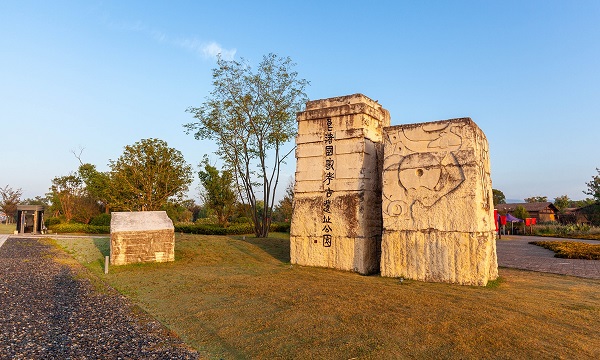story continues

liangzhu national archaeological site park photo: vcg
with newly unearthed relics such as stone axes and chisels as highlights, several "factories" that manufactured everyday stone utensils during the neolithic age have recently been discovered in suburban hangzhou, east china's zhejiang province.
although the early "industrial remains" were found scattered in two different local archaeological sites, they share the "liangzhu culture" label, which is one of china's most important historical ruins that witnessed the country's cultural and historic evolution over a 5,000-year period.
the liangzhu culture is known for a treasure trove of stellar discoveries like the world's earliest-known water conservancy system. the newly-discovered stone culture is yet another piece of a historical jigsaw puzzle as historians and archeologists work to patch together a more complete liangzhu cultural panorama.
stone factories
the discovery of stone processing factories was recently revealed at a conference at which a number of major archaeological discoveries from zhejiang in 2023 were unveiled.
the ancient stone factories were discovered at the shenjiali and shenjiafan archaeological sites. the shenjiafan site, in particular, appears to be of the most relevance to liangzhu culture. objects such as a stone knife, adze and a boat-shaped plate were found amongst a total of 37,000 relics discovered at the site.
the history of the shenjiafan ruins can be divided into several historical periods from the neolithic age of "liangzhu period" to the ming (1368-1644) and qing (1644-1911) dynasties, wang ningyuan, a research fellow at the zhejiang provincial institute of cultural relics and archaeology, told the global times. the historical tools found at the site are most likely of "liangzhu production" because stone relics discovered from the liangzhu site and the shenjiafan site were "highly similar," wang said.
taking a piece of pierced stoneware as an example, the piece is characterized by a well-defined round hole that looks machine-drilled. such great craftsmanship shows that those stone processing factories were "highly professional and boasted perfectly designed manufacturing systems" while exhibiting ancient chinese ingenuity, archaeologist wang meng, told the global times. he emphasized that such "stone ingenuity" was rooted in china's time-honored agricultural tradition.
"new discoveries at the two sites shed a light on our future analysis of the entire production chain of the liangzhu stone tools," wang meng told the global times.
just like other civilizations that progressed, with new technologies emerging to reflect social and cultural growths, the liangzhu culture also progressed from its people using stones to the "age of jade" when iconic ritual objects such as jade cong was later developed. a jade cong is often shaped as a three-dimensional cube with engraved patterns such as bird motifs on its four sides. in ancient times, a cong was often used as a vessel during an important sacrificial ceremony. it was a symbol of power and wealth for ancient liangzhu people.
prolific jade productions have made liangzhu culture renown around the world.
at the same time, the gradually derived diversity of liangzhu jades reflects how social and cultural traditions change over thousands of years.
a weeding implement used by ancient people was unearthed at the liangzhu site and is widely seen as an iconic piece that shows jade's introduction into agricultural practices. following the discovery, objects like cong and bi, another type of ritual stoneware, were also unearthed. the objects were often used by people during important rituals and revealed how the precious stone was used to shape liangzhu cultural belief.
"the liangzhu jade culture highlights how chinese civilization evolved based on showing respect to people and nature," wang meng told the global times.
creative ip
the liangzhu site might appear to be "outdated" due to its historical nature, yet the "liangzhu culture," along with its culture of deference continues to this day. now, the liangzhu civilization is not just an archaeological site, but a cultural ip that connects chinese culture with the world.
an international forum called the liangzhu forum was launched in december 2023 to attract international scholars and sinologists from countries such as qatar, brazil and greece.
borrowing from the liangzhu cultural virtues of generosity and humility likened to jade, the forum was a special occasion that encourages collaborations between china and other countries in the fields such as cultural heritage conservation, archaeology and education.
the agenda has effectively increased the cultural connections between china and the belt and road initiative member countries like greece. styliani chrysoulaki, general director of the archaeological museum of heraklion in greece, told the global times that the two countries' collaborations in the museum sector can be important and fruitful to inspire the world, especially when china and greece are both countries with long cultural civilizations.
other than cultural events, classic elements such as the jade bird have been turned into cultural creative ips. classic liangzhu aesthetic patterns are used in the design of everyday products.
such designs have attracted predominantly young consumers to learn about the time-honored liangzhu history.
"the mere conservation of chinese legacy is not enough; we need to design creative projects to engage young generations. the best way to carry on liangzhu culture is to make people remember it and feeling confident about the culture," cultural creative industries insider yao yu, told the global times.
-
'nice' to meet you, hangzhou
may 6, 2024

